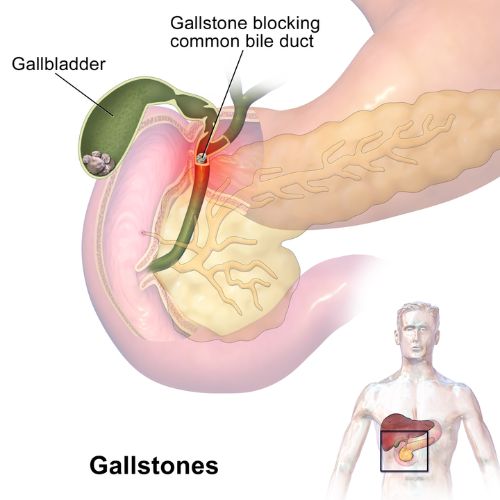Swift and Effective Gallbladder Stones Treatment Near You
- Trusted Doctors & Top Hospitals
- Consultations with Expert Surgeons
- Extensive Support Throughout Your Treatment
Doctors
Hospitals
Presence in City
Book An Appointment
Understanding Gallbladder Stones : An Overview
We all have a small, pear-shaped organ called the gallbladder, located just below the liver. Its primary role is to store bile, a digestive fluid produced by the liver that helps break down fats. Gallstones are solid deposits that form in the gallbladder and are made up of cholesterol, bilirubin, or other substances. These stones can range in size from tiny grains to large golf ball-sized formations.
While gallstones usually stay in the gallbladder, they can sometimes move into the common bile duct (CBD), causing a condition known as Choledocholithiasis. Stones found in the CBD are termed primary CBD stones, whereas those that travel from the gallbladder are called secondary CBD stones.
Keep reading to learn more about gallbladder stones, including their symptoms, causes, diagnostic methods, prevention strategies, and treatment options.
Disease name
Gallbladder Stones
Symptoms
Abdominal pain, nausea, vomiting, indigestion, and jaundice
Causes
Excess cholesterol, bile production issues, obesity, pregnancy, rapid weight loss, and certain medical conditions
Diagnosis
Ultrasound, CT scan, and blood tests
Treated By
Gastroenterologist, Surgeon, Hepatologist
Treatment Options
Medication, Lithotripsy, Cholecystectomy (surgical removal of the gallbladder)
What Are Gallbladder Stones?
Gallbladder stones are solid particles that develop in the gallbladder, a crucial digestive organ. These stones can be as small as a grain of sand or as large as a golf ball. They form when substances in bile, such as cholesterol or bilirubin, become concentrated and crystallize.
Gallstones can be classified into two main types:
Cholesterol Stones
These are the most common type and are primarily made of hardened cholesterol. They can range in colour from yellow to green.
Pigment Stones
These are smaller and darker, composed of bilirubin, a substance produced from the breakdown of red blood cells.

Our Specialist Best Doctors for Gallbladder Stones
Symptoms of Gallbladder Stones
Typically, gallbladder stones don’t cause symptoms. However, when they do, they can lead to significant discomfort and may indicate a more serious issue, such as gallbladder inflammation or infection. Identifying the signs and symptoms of gallbladder stones is the first step in finding relief.
- Upper Abdominal pain
- Excessive sweating
- Vomiting
- Nausea
- Feeling of fullness
- Flatulence or gas
If a gallstone blocks the bile duct or moves to other organs like the pancreas, you may experience more serious symptoms, such as:
- Fever
- Chills or shivering
- Jaundice (yellowing of the skin and eyes)
- Loss of appetite
- Rapid heartbeat
- Itchy skin
- Confusion
If you experience any of these symptoms, it’s important to contact your gastroenterologist promptly.

Causes of Gallbladder Stones
Here are several possible causes of gallstones that should not be overlooked and can be prevented or managed with lifestyle changes.
- Genetics: A family history of gallstones can increase your risk, although having a genetic predisposition does not guarantee you will develop them.
- Diet: High-fat and high-cholesterol diets can contribute to gallstone formation. Consuming foods like red meat, deep-fried items, sugary drinks, and high-fat snacks can elevate this risk.
- Obesity: Excess body weight can lead to changes in cholesterol and bile levels, increasing the likelihood of gallstones.
- Hormones: Hormonal fluctuations, particularly elevated estrogen levels during pregnancy, menopause, or from birth control pills, can raise the risk of gallstones.
- Rapid Weight Loss: Losing weight quickly due to drastic dieting or bariatric surgery can lead to gallstone formation, as the liver may secrete bile more rapidly, contributing to gallstone development.
Diagnosis of Gallbladder Stones
Diagnosing gallbladder stones typically involves a combination of physical examinations, laboratory tests, and imaging techniques.
- Physical Exam: The doctor will review your medical history and examine your abdomen for tenderness or lumps. Blood tests may be ordered to check for infection or inflammation.
- Imaging Tests: If gallstones are suspected, imaging tests help confirm their presence:
- Ultrasound: Uses sound waves to create images of the gallbladder and surrounding organs.
- CT Scan: Provides detailed cross-sectional images of the abdomen.
- MRI: Uses magnets and radio waves to produce detailed images of gallstones.
- ERCP: If other tests are inconclusive, endoscopic retrograde cholangiopancreatography (ERCP) may be used. This involves inserting a tube through the mouth to inject dye and take X-ray images to detect stones.
Why choose us
Get Lasting Relief from Anal FIssure Near You
some description text will go here some description text will go here some description text will go here some description text will go.
Trusted Doctors & Top Hospitals
Lorem ipsum dolor sit amet, consectetur adipiscing elit. Ut elit tellus, luctus nec ullamcorper mattis, pulvinar dapibus leo.
Consultations with Expert Surgeons
Lorem ipsum dolor sit amet, consectetur adipiscing elit. Ut elit tellus, luctus nec ullamcorper mattis, pulvinar dapibus leo.
Extensive Support Throughout Your Treatment
Lorem ipsum dolor sit amet, consectetur adipiscing elit. Ut elit tellus, luctus nec ullamcorper mattis, pulvinar dapibus leo.

Treatment Options for Gallbladder Stones
Treatment for gallstones depends on the severity of symptoms and the presence of complications. Options include:
Medications:
Oral Dissolution Therapy
Medications like ursodeoxycholic acid can help dissolve cholesterol stones over time.
Pain Relief
Non-prescription pain relievers may be used to manage discomfort associated with gallstones.
on-Surgical Treatments:
Extracorporeal Shock Wave Lithotripsy (ESWL)
This technique uses shock waves to break up gallstones into smaller pieces that can be passed more easily.
Endoscopic Techniques
ERCP may be used to remove stones from the bile ducts without the need for surgery.
Laparoscopic Cholecystectomy (Keyhole Surgery): This minimally invasive procedure involves small abdominal incisions through which a laparoscope and surgical tools are inserted. The gallbladder is removed with minimal pain, quicker recovery, and
Open Cholecystectomy: This involves a larger abdominal incision to remove the gallbladder. It is used when laparoscopic surgery is not suitable due to complications or extensive scarring.
When to Consider Surgery for Gallbladder Stones
Surgery may be necessary if gallbladder stones lead to severe discomfort or complications. It is often recommended in the following situations:
- Persistent Symptoms: When pain and other symptoms continue despite non-surgical treatments.
- Complications: If stones cause inflammation (cholecystitis), bile duct blockages, or infections.
- Frequent Attacks: For individuals who experience recurrent gallstone episodes that disrupt daily life.
- Non-Responsive to Medication: When medications or non-surgical methods fail to provide relief.
Cost of Gallbladder Stones Treatment
The cost of gallbladder stones treatment can vary based on the type of procedure, the hospital or clinic, and location. Here is a general estimate for the cost of different gallbladder stones treatments in India:
Surgery Name | Surgery Cost |
Laparoscopic Cholecystectomy | ₹60,000 to ₹1,00,000* |
Open Cholecystectomy | ₹80,000 to ₹1,50,000* |
Oral Dissolution Therapy | ₹15,000 to ₹30,000* |
Extracorporeal Shock Wave Lithotripsy (ESWL) | ₹30,000 to ₹50,000* |
Endoscopic Retrograde Cholangiopancreatography (ERCP) | ₹25,000 to ₹40,000* |
*Terms and Conditions Apply
When to Consult a Doctor for Gallbladder Stones
It’s essential to seek medical advice if you experience symptoms related to gallbladder stones. Consider consulting a doctor if you have:
- Severe Abdominal Pain: Intense pain, especially in the upper right abdomen, that persists or worsens.
- Nausea and Vomiting: Persistent nausea and vomiting associated with abdominal discomfort.
- Jaundice: Yellowing of the skin or eyes, indicating possible bile duct obstruction.
- Digestive Issues: Ongoing bloating, gas, or indigestion that disrupts daily activities.
Early consultation can help diagnose the condition accurately and prevent complications. A doctor will assess your symptoms, perform necessary tests, and recommend appropriate treatment to manage your condition effectively.
Frequently Asked Questions
Yes, in some cases, gallstones can be dissolved using medications. Also, if your gallstones aren’t causing any pain or discomfort, you may not need any treatment. But if they’re triggering pain or complications, surgery (cholecystectomy) is the best long-term solution.
If you have gallbladder stones, it’s important to avoid certain foods that can cause pain, inflammation or discomfort. These can include fatty or fried foods, dairy products, red & processed meats, refined carbs, sugary food, carbonated & caffeinated drinks and spicy food.
Bile duct injury is the most common complication of this procedure. Although quite rare, it can happen. The bile duct is a delicate part that can accidentally get nicked or damaged during surgery and lead to bile leakage or blockage – this can cause pain, jaundice or even infection. That said, don’t let it worry you too much – in the hands of skilled surgeons, laparoscopic gallbladder removal is a safe procedure with minimal risks. And even if complications arise, they can be managed effectively.
The surgery takes nearly 30 to 60 minutes, depending on the complexity of the case and the overall health of the patient.
Post-op patients may experience mild discomfort but it’s usually manageable with pain medications. Most people are able to resume light activities within a few days and return to normal routines in about a week.
With CureMe, booking a consultation is super easy and seamless. Simply visit our website, check out the list of all the specialists near you and then with one click, you’ll be able to book an appointment with them. If you’re facing any issue related to this, our team is here to guide you every step of the way. Just give us a call.
If gallstones are not causing any symptoms, they may not need treatment. But if left untreated in symptomatic cases, they can lead to serious complications like gallbladder inflammation, bile duct blockage or even pancreatitis and these conditions require urgent medical attention.

Still Have a Question?
Reach out to our healthcare experts at Cure Me for discussing any concerns and queries regarding Gallbladder Stones Treatment.
Get the Best Gallbladder Stones Treatment with Cure Me Experts
Gallbladder stones can be effectively managed with advanced, minimally invasive techniques. At Cure Me, our skilled surgeons specialize in state-of-the-art procedures to ensure a quicker recovery and reduced discomfort. Our experts use the latest methods to provide safe and effective treatment tailored to your specific needs. Connect with our specialists to discuss your condition and explore the best treatment options for optimal relief. With Cure Me, you’re in expert hands for a smoother, pain-free journey towards better health. Reach out to us Today!.
Start Your Search


